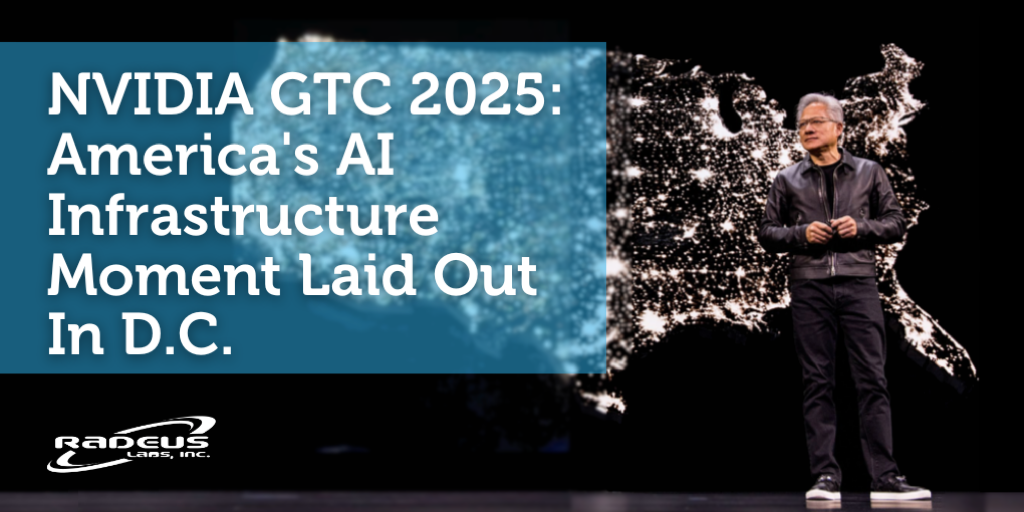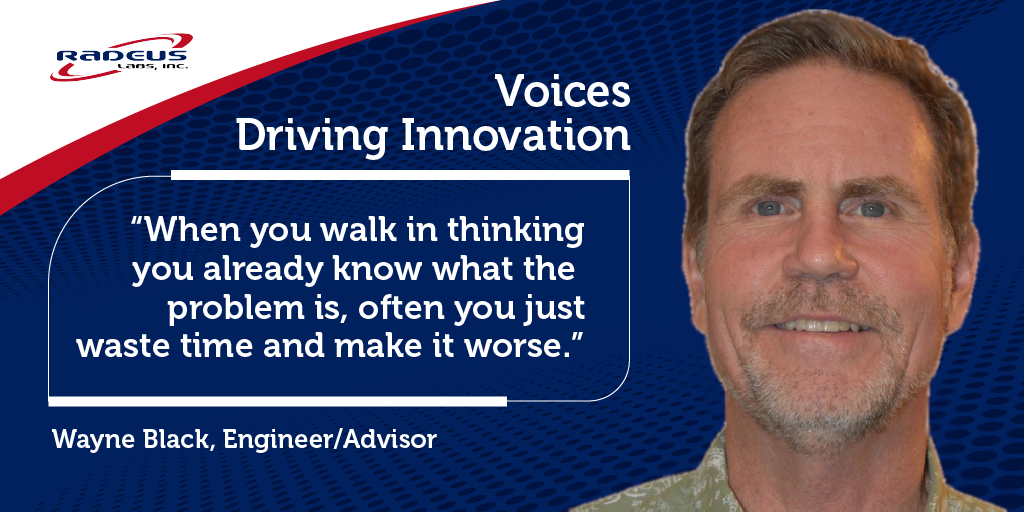 Last week, the Radeus Labs team joined the global AI community in Washington, D.C. for the NVIDIA GTC, CEO Jensen Huang's flagship conference that has become the definitive gathering for accelerated computing, artificial intelligence, and the infrastructure powering the next industrial revolution.
Last week, the Radeus Labs team joined the global AI community in Washington, D.C. for the NVIDIA GTC, CEO Jensen Huang's flagship conference that has become the definitive gathering for accelerated computing, artificial intelligence, and the infrastructure powering the next industrial revolution.
This year the event was held in the nation's capital with unmistakable urgency and national purpose. GTC 2025 marked a pivotal moment: America's return to advanced manufacturing, the convergence of AI with physical infrastructure, and what Jensen called "a new computing model for the first time in 60 years."

The atmosphere on opening day was electric as Jensen delivered a nearly two-hour keynote packed with major announcements and a clear message about American technological leadership. During the presentation, NVIDIA's market capitalization hit $5 trillion-, underscoring the company's central role in the AI revolution.
Jensen emphasized we're witnessing two simultaneous platform shifts: from CPU to GPU-accelerated computing, and more fundamentally, AI evolving from software into workers that can use tools and perform labor. "AI is not a tool. AI is work," he declared, a distinction that reframes the entire industry.
Made in America: Manufacturing Returns
 One of the conference’s most striking announcements centered on domestic manufacturing. NVIDIA showcased the full production journey of its revolutionary Grace Blackwell NVL72 system, highlighting a U.S.-based supply chain that spans silicon wafers produced in Arizona and Indiana, with final assembly in Texas and California.
One of the conference’s most striking announcements centered on domestic manufacturing. NVIDIA showcased the full production journey of its revolutionary Grace Blackwell NVL72 system, highlighting a U.S.-based supply chain that spans silicon wafers produced in Arizona and Indiana, with final assembly in Texas and California.
The demonstration underscored a significant milestone in bringing more advanced semiconductor and AI system manufacturing steps back to American soil. A powerful video traced the process from wafer to rack-scale AI supercomputer; 1.2 million components, 2 miles of copper cabling, and 130 trillion transistors in total.
The emphasis on American manufacturing was unmistakable, a shift from the Silicon Valley GTC held earlier in the year. This D.C. event centered squarely on America's role in leading the AI revolution, with Jensen highlighting the importance of public-private partnerships in advancing the nation's computing infrastructure and scientific capabilities.
Looking ahead, NVIDIA revealed the Vera Rubin architecture, the next-generation system expected in production around this time next year, completely cableless, 100% liquid-cooled, and delivering 100 petaflops in a single rack.
SC25 Highlights
Telecommunications Gets an AI Upgrade
In a partnership that could reshape America's position in global telecommunications, NVIDIA announced a collaboration with Nokia to build AI-native 6G networks on the new NVIDIA Arc platform. This software-defined system combines Grace CPUs, Blackwell GPUs, and ConnectX networking to enable wireless base stations that perform both communication and AI processing simultaneously.
Nokia brings 7,000 essential 5G patents. Combined with NVIDIA's AI capabilities, this collaboration positions American innovation at the center of the next wireless revolution, a strategic imperative for both commercial applications and national security.
Quantum Computing Meets Classical Supercomputing
 NVIDIA unveiled NVQLink, a revolutionary interconnect architecture that directly couples quantum processors with GPU supercomputers. Rather than replacing traditional systems, quantum computers will work alongside them, fused into platforms where each processor handles what it does best.
NVIDIA unveiled NVQLink, a revolutionary interconnect architecture that directly couples quantum processors with GPU supercomputers. Rather than replacing traditional systems, quantum computers will work alongside them, fused into platforms where each processor handles what it does best.
With support from 17 quantum computing companies and eight Department of Energy laboratories, the announcement signals serious momentum toward quantum advantage.
Physical AI: Where Digital Meets Reality
Perhaps the most visually stunning portion of the keynote showcased NVIDIA's vision for Physical AI, artificial intelligence that understands and operates in the real world.
Three interconnected computing platforms work together: Grace Blackwell NVL72 for training AI models, NVIDIA Omniverse for simulating digital twins, and Thor/Jetson for operating robots in the physical world.
The Humanoid Robot Revolution
AI Factories and Enterprise Partnerships
NVIDIA introduced a new paradigm: AI factories: Purpose-built facilities designed to generate tokens (the computational output of AI models) at the highest quality, fastest rate, and lowest cost possible.
 The company also announced critical enterprise partnerships:
The company also announced critical enterprise partnerships:
- CrowdStrike: Integration to create "speed of light" cybersecurity with AI agents in the cloud and at the edge.
- Palantir: Deep integration with Ontology to process structured and unstructured data at unprecedented scale and speed.
- Uber: Partnership to connect NVIDIA Drive Hyperion vehicles (a standardized autonomous driving platform) into a global robotaxi network.
Connecting with Industry Leaders
Throughout the event, the Radeus team connected with key partners and industry leaders, including:
 PNY Technologies had a strong presence, with Willy Ortiz delivering an insightful presentation on enterprise-grade GPU solutions. PNY's focus on enterprise-grade reliability and long lifecycle support resonates with Radeus Labs’ own commitment to sustained performance in mission-critical environments.
PNY Technologies had a strong presence, with Willy Ortiz delivering an insightful presentation on enterprise-grade GPU solutions. PNY's focus on enterprise-grade reliability and long lifecycle support resonates with Radeus Labs’ own commitment to sustained performance in mission-critical environments.- Leading Technologies continues to be an exceptional partner, facilitating connections throughout the event and hosting a lunch that brought together key players in the GPU computing ecosystem.
- The Radeus team also discovered Atolio, an AI-powered enterprise search solution that stood out by offering true on-premise deployment options, a rarity in an industry where most solutions require cloud connectivity.
A Community United by Mission
 What distinguished GTC 2025 was the palpable sense of national purpose. The emphasis on American leadership, energy abundance, and technological superiority threaded through the entire event.
What distinguished GTC 2025 was the palpable sense of national purpose. The emphasis on American leadership, energy abundance, and technological superiority threaded through the entire event.
For the defense and aerospace community (the core market for Radeus Labs' ruggedized computing solutions) the implications are profound. The convergence of AI, edge computing, quantum processing, and physical robotics is being deployed now, and the infrastructure decisions being made today will determine which nations lead in military readiness and scientific discovery for decades to come.
With booth space commanding $50,000 for a 10x10 space, exhibitors were making significant investments. Yet the consensus was clear: the visibility and business opportunities justified the cost. The Radeus team came away convinced that GTC is worth attending annually, with potential opportunities to exhibit in future years.
Looking Ahead
We've reached an inflection point. AI models are smart enough that people willingly pay for them. That revenue funds more compute infrastructure, which enables smarter models, which drives more adoption. Moore's Law may have ended, but extreme co-design, massive scale, and American manufacturing are keeping performance improving exponentially.
 Come Visit Us at SC25 in St. Louis
Come Visit Us at SC25 in St. Louis
The journey continues November 16-21 in St. Louis at Booth 6833 at SC25, the International Conference for High Performance Computing, Networking, Storage, and Analysis.
Stop by to discuss how Radeus Labs' mission-critical computing solutions fit into the AI-accelerated future we witnessed at GTC, or schedule a meeting with our team.





